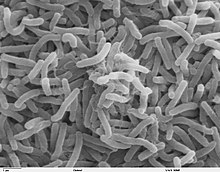


LV-MLR, the aircraft the event took place in.[citation needed]
| |
| Occurrence | |
|---|---|
| Date | 14 February 1992 (1992-02-14) |
| Summary | Mass foodborne illness outbreak by cholera from airline meal |
| Site | In flight from Lima, PerútoLos Angeles, United States |
| Aircraft | |
| Aircraft type | Boeing 747-200B |
| Operator | Aerolíneas Argentinas |
| Registration | LV-MLR |
| Flight origin | Ministro Pistarini International Airport, Buenos Aires, Argentina |
| Last stopover | Jorge Chávez International Airport, Lima, Perú |
| Destination | Los Angeles International Airport, Los Angeles, United States |
| Passengers | 336 |
| Crew | 20 |
| Fatalities | 1 |
| Injuries | 75 |
| Survivors | 355 |
On 14 February 1992, food contaminated with cholera was distributed to the passengers on Aerolíneas Argentinas Flight 386, sometimes referred to as the Valentine's Day flight.[citation needed] One of the passengers died from the illness.
On 14 February 1992, an Aerolineas Argentinas Boeing 747-287B, registration LV-MLR,[citation needed] arrived in Los Angeles, California, United States, inbound from Ministro Pistarini International Airport, Buenos Aires, Argentina, via a scheduled stopover at Jorge Chávez International Airport, Lima, Perú.[1][2][3] There were 336 passengers and 20 crew members on board the Lima–Los Angeles leg of the flight.[4] Out of the 336 passengers, the United States was the final destination for 297 of them.[1] Two passengers selected Canada as their final destination, while 37 selected Japan.[1][3]

Contaminated shrimp entered the aircraft in Lima, a year after a cholera outbreak began in Peru.[2][3][4] Five passengers showed signs of the illness immediately after landing at Los Angeles International Airport.[2] Several days later that number rose to 76.[5] One of them, a man in his early seventies, died from the illness.[1][3][6] The cholera on the contaminated food did not spread to other areas within the United States.[1]
By March 4, 172 passengers and one crew member submitted to cholera tests. Of the people found with cholera, all of them except for two sat in economy class; the first class passengers ate from a menu differing from the economy class menu. By March 5, Los Angeles County Department of Health Services officials determined that the shrimp contained cholera. As some passengers who fell ill did not eat the food, the officials did not eliminate other possibilities.[citation needed]
Even though the Peruvian caterer that provided the food to Aerolíneas Argentinas in Lima also provided service to other companies the same day and no signs of the illness were reported, the Argentine flag carrier blamed it for entering the contaminated food into the aircraft.[7] This led to a controversy that eventually ended with the airline banned from operating into Peruvian territory.[2]
An investigation by the Food and Drug Administration highlighted the problem patchwork of regulations for food safety.[8]
The International Civil Aviation Organization (ICAO) stated that the responsibility for the safety of the operator organization is not changed by subcontracting of catering or other services to third parties.[9]
In 1995, the World Health Organization in consultation with the ICAO and the International Maritime Organization developed explicit agreements on the management of transmission risks for cholera and other infectious diseases by air and sea.[10][11][12][13][14] In 1998 this led to improvements in aircraft disinfection procedures.[15]
The ICAO now takes the advice of the International Travel Catering Association.[16]
|
Aviation accidents and incidents in 1992 (1992)
| |
|---|---|
Jan 3 Jan 7 Jan 7 Delta Air Lines Flight 1581 Jan 20 Jan 28 Azerbaijani Mil Mi-8 shootdown Feb 14 Aerolíneas Argentinas Flight 386 Feb 15 Air Transport International Flight 805 Mar 22 Mar 31 Jun 6 Jun 7 Jun 8 GP Express Airlines Flight 861 Jul 20 Jul 24 Jul 30 Jul 31 Thai Airways International Flight 311 Jul 31 China General Aviation Flight 7552 Aug 27 Sep 4 Sep 26 Nigerian Air Force C-130 crash Sep 28 Pakistan International Airlines Flight 268 Oct 4 Oct 18 Merpati Nusantara Airlines Flight 5601 Nov 14 Nov 24 China Southern Airlines Flight 3943 Dec 21 Dec 22 Libyan Arab Airlines Flight 1103 | |